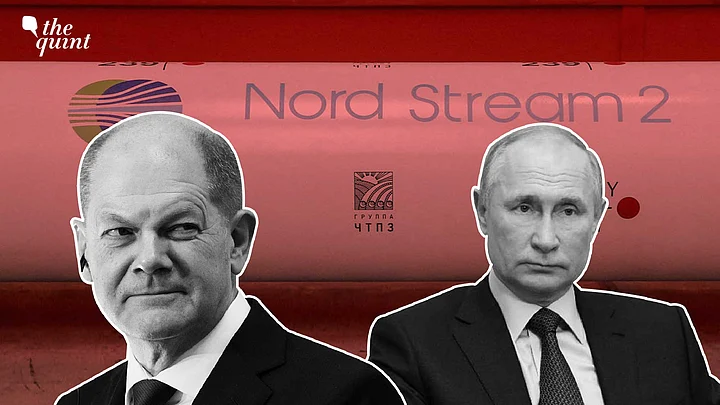(This story was originally published on 24 February 2022. It is being republished from The Quint's archives in light of the US ban on Russian oil imports announced on 8 March.)
In light of Russia violating Ukrainian sovereignty by sending its troops to the Donbas region, German Chancellor Olaf Scholz ruled out certifying the Nord Stream 2 pipeline (costing more than $10 billion) on 22 February.
Combined with its predecessor, Nord Stream, the two pipelines could supply 110 billion cubic metres of gas to Europe on an annual basis.
That is more than 25 percent of all the gas that EU countries use per year, according to the BBC.
Pulling the plug was a huge decision for Germany, Europe's largest economy, as it is dependent on Russia for more than 60 percent of its gas supply.
Additionally, because it takes away from it a cash cow, Russia might retaliate by reducing gas exports.
Russia, to a large extent, is monopolistic, when it comes to supplying gas to Europe.
Countries like Austria, Lithuania, and Finland rely almost entirely on Russia for gas.
Others like Germany, Poland, France, and Italy also need Russia for the same, some more than others.
If Russia has a monopoly, however, then Europe, too, can be said to have a kind of a monopsony, that is, it is the former's primary purchaser.
David Goldwyn, who worked in international energy affairs under the Obama administration, told The New York Times that, "While Europe is hugely dependent on Russian gas, Russia is hugely dependent on the European market and can’t easily substitute for it".
Russia has enormous amounts of money to lose if Europe were to find alternative sources of gas and energy.
In this situation of interdependence, who tends to have more leverage?
A Few Facts
Some of the following facts should be kept in mind while navigating through the rest of the article:
Russia is the globe's third-largest producer of oil and and the second-largest producer of natural gas.
According to data from the Council on Foreign Relations, these fossil fuels account for approximately 14 percent of the country's economic output.
The revenue from the energy sector constitutes around 40 percent of the Russian federal budget.
Europe, on the other hand, relies on Russia for more than 38 percent of its natural gas.
This gas is mostly transported through two pipelines:
The Yamal – Europe pipeline, which supplies gas to Poland and Germany via Belarus
Nord Stream, the predecessor to Nord Stream 2, which supplies gas to Germany via Ukraine (NS2 bypasses Ukraine)
Norway is next on the list of gas suppliers to Europe, accounting for just more than 20 percent, according to Reuters.
In fact, around 60 percent of the EU's energy requirements are imported. Russia, however, is the main exporter.
Even the threat of an invasion of Ukraine, or the threat of a European war, can send oil and gas prices soaring.
Oil prices broke $100 on 24 February when the Russian 'special military operation' was announced to 'de-militarise' Ukraine.
All this is to say that while Russia has leverage on the supply side, Europe has leverage on the demand side.
How Can Europe Rely Less on Russia?
European countries have already started planning on how to diversify their natural gas imports.
One solution is LNG or Liquified Natural Gas.
The US is the EU's largest LNG supplier, sending around 400 million cubic meters of LNG per day in the near past.
Expanding new production and increasing exports of LNG, however, cannot happen overnight.
An increase in supply of LNG to Europe, should Russia cut off gas, would result in a reduction of LNG supply elsewhere until production increases.
Another option is to get more gas from Algeria and Azerbaijan, which currently supply about 20 percent and 10 percent of Europe's gas, respectively.
A final alternative, albeit a temporary one, is Europe's gas storage.
The European Commission, according to leaked draft, is mulling over mandating a minimum gas storage on its member states to ensure gas supply security in the continent, according to an S&P Global report published on 23 February.
Germany agreed with this proposal earlier this week.
"We must ensure that gas storage sites are full before the winter," German economy minister Robert Habeck had stated on 21 February, Reuters reported.
What Are Russia's Options?
Russia's best bet is to look towards China.
They signed a 30-year contract in 2014 under which Russia would supply gas to China through a new pipeline called the Power of Siberia.
The partnership with Beijing over energy will help Moscow to attain revenue if push comes to shove with Europe.
Russian gas may come from the same field that the US sanctioned in 2015 after Russia's annexation of Crimea.
Another way in which Russia could support itself is by using its foreign reserves that are now worth approximately $640 billion.
They are the fourth largest in the world, and are equal to almost one-and-a half years of Russia's export revenues.
The 'de-dollarisation' of these reserves, with the Chinese renminbi and gold replacing the US dollar, could keep the Russian economy propped up for a while, even without its gas exports to Europe.
